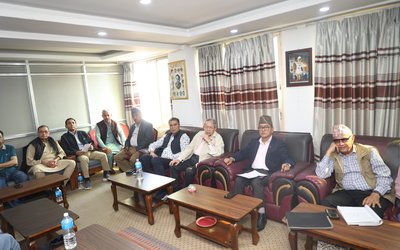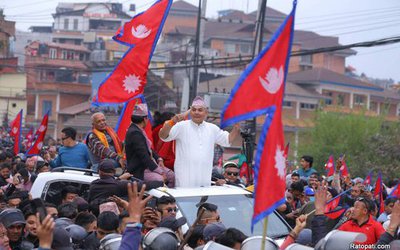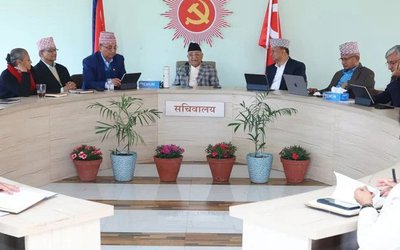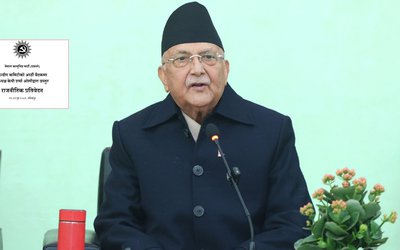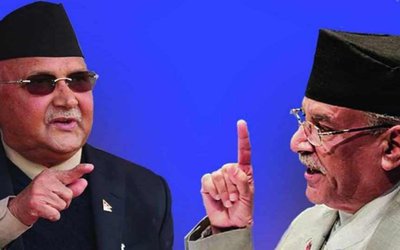
Nepal-India relations are returning to normalcy following the visit of deputy prime minister Kamal Thapa to India and the recent statement of Indian External Affairs Minister Sushma Swaraj. In the meantime, the statement given by Nepalese vice-president Nanda Bahadur Pun following his visit to China is an indication that there is a possibility of a high level visit from China.
With an abrupt cancelation of the India visit schedule of President Vidhya Bhandari, Nepal-India relations had reached a low. However, other high-level bilateral meetings are continuing between the two countries.
With the visit of Prime Minister Oli to China, Nepal-China bilateral meetings have become more frequent. Chinese President Xi Jinping is likely to visit Nepal in October after participating in the Brazil-Russia-India-China-South Africa (BRICS) summit in Panaji, according to the South China Morning Post.
Vice-President Pun recently returned from a weeklong visit to Kunming, which hosted a China-South Asia expo, apart from attending a meeting of the China-South Asia think tank forum.
Releasing a book by former ambassador to Russia Hiranya Lal Shrestha on Nepal China Relations, Prime Minister K.P. Sharma Oli also hinted at the imminence of a high level visit from Nepal’s northern neighbor.
President Xi is expected to visit the Himalayan nation, which is actively engaged in balancing ties between India and China, on October 16, following the BRICS summit that concludes on the same day.
Observers see Chinese Admiral Sun Jianguo's recent visit is an “indication” to President Xi’s visit to Nepal.
Apart from an “assessment” of the possibility of Chinese president Xi’s visit, two other topics were prominently discussed during Admiral Sun’s talks with Nepal’s Defense Minister Bhim Rawal and Chief of Army Staff General Rajendra Chhetri.
During his visit, the Admiral discussed the extension of the Qinghai-Tibet railway to Kathmandu and further to Lumbini, close to the border with India. Both sides are actively pursuing improvement of trans-Himalayan connectivity, with the railways playing a leading role.
Last month an international freight train left for Nepal from Lanzhou in China’s Gansu province, to cover a distance of 2,431 km to Xigaze in Tibet, the last railhead. The goods were then to be transported by road to the Geelong land port in Nepal, and further to Kathmandu, 160 km away.
Second, the two sides discussed Nepal’s integration in China’s One Belt One Road, Eurasian connectivity project. China-Nepal ties acquired fresh momentum during the visit to China by Nepal’s Prime Minister K.P. Sharma Oli in March. During that visit, President Xi was quoted as saying that, “Nepal can be a bridge between China and India.”
Following Prime Minister Oli’s visit to China, the frequencies of high level meeting between the two countries are growing. China and Nepal are also holding foreign secretary level talks in the third week of June in Kathmandu, where the status of all the accords that were reached during Oli’s visit would be reviewed.
Defense Minister Bhim Rawal and Deputy Chief of the Joint Staff Department of China's Central Military Commission Sun Jianguo pledged to enhance defense cooperation between the two countries.
"The two sides exchanged views on various matters relating to strengthening the defense cooperation," said Mahesh Dahal, secretary at the ministry.
During the meeting held at Nepal's Defense Ministry in Kathmandu, Admiral Sun said that China wants to see political stability and economic prosperity in Nepal, according to secretary Dahal. He also praised Nepal's adherence to the one-China policy.
"China has remained our friendly neighbor. Our relationship with China has remained trouble-free all the time," he said. "The minister reiterated Nepal's one-China policy and said we will not allow any anti-Chinese activities inside our territory."
Stating that Nepal has marched toward a new era after the promulgation of the new Constitution in September last year, the minister expected China's continual support in the days to come, particularly in socio-economic development of the country.
As Nepal’s interactions with China and India are growing, yet Nepal is still to prepare ways to benefit from the intensification of the relationship.

Keshab Poudel
Poudel is the editor of New Spotlight Magazine.
- KUL MAN GHISING: Bowing Down To The People
- Apr 13, 2025
- POLITICAL VIOLENCE: Culture of Impunity
- Apr 11, 2025
- PM OLI MEETS PM MODI: No Progress
- Apr 09, 2025
- PM OLI’S THAILAND VISIT: Flip Flop
- Apr 08, 2025
- FM Dr. Deuba’s India Visit: Mission Aborted
- Mar 26, 2025
